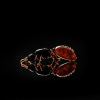Titanomyrma gigantea was a colossal ant species which lived during the Eocene. We have fossils of its queens, which grew up to 2.4 inches long, and its males, which grew to 1.2 inches. The species did not have a sting and somewhat resembles a modern formicine. Other than that, we know nothing of its biology. What did its workers look like? How big were they? What did they eat? To start off, I highly doubt that they were army ants of any kind, as their queens dispersed normally with wings, and otherwise resembled bigger versions of the ones we find. Army ant queens look like swollen termite queens and have no wings or eyes, instead breaking off from their mother colonies with about half the workers. I'll also say that I don't think they were polygynous either. Polygynous species tend to have tiny queens, not hummingbird sized ones. Just look as the strictly monogynous Camponotus pennsylvanicus, and then at the polygynous Formica montana. We could go with my buzzkill theory that the workers were 1 millimeter long like in Carebara castanea, which has huge queens but tiny workers. What do you guys think?
- Formiculture.com
- Forums
- Gallery
- Members
- Member Map
- Chat




















